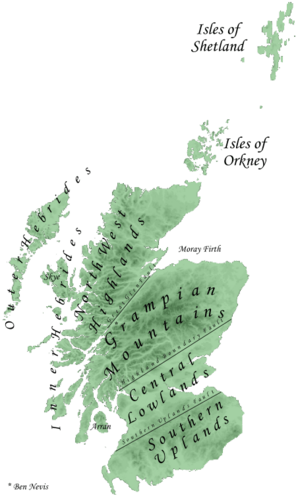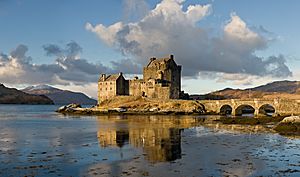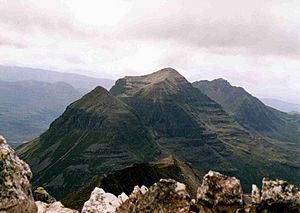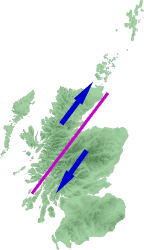Northwest Highlands facts for kids

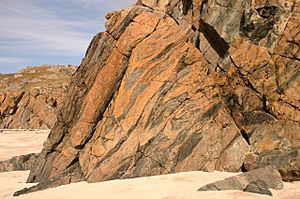

The Northwest Highlands are a large, beautiful part of northern Scotland. This area makes up about one-third of Scotland's land. It is separated from the Grampian Mountains by a long valley called the Great Glen.
The Caledonian Canal also helps divide this region from the rest of Scotland. This canal stretches from Loch Linnhe in the west, through Loch Ness, all the way to the Moray Firth in the north.
The Highlands are built on some of the oldest rocks in Scotland. These ancient rocks are called Lewisian gneiss. You can also see amazing rock formations of dark red or gray Torridonian sandstone poking out of the gneiss. Some mountain peaks, like Beinn Eighe and Canisp, have light gray or white Cambrian quartzite on top.
Inverness is the biggest city in this region. It is often called the "Capital of the Highlands." Inverness is the main center for the Highland Council area.
Contents
Climate in the Highlands
The weather in the Northwest Highlands changes a lot depending on how high up you are. Summers here are usually wet and warm, but the average temperature is below 17°C (62.6°F).
Winters are mild near the coast and at lower elevations. However, as you go higher up the mountains, winters become much colder and snowier. Some mountains can have snow for up to six months of the year.
Naturally, this area would be covered in large forests. These forests would have birch, pine, and mountain shrubs. You can still see examples of these forests in places like Glen Affric. Snow can stay on the ground for over a month, sometimes up to 105 days. But it usually doesn't stay long at the coast or in very low areas.
Geography of the Northwest Highlands
This region is known for its steep mountains. These mountains were carved by ancient glaciers. You will also find many deep valleys and flat plains scattered throughout the area. Many different islands are located just off the coast.
It is common to find mountains around 800 meters (2,600 feet) tall or even taller. Many peaks in the Northwest Highlands are over 1,000 meters (3,300 feet) high.
The Northwest Highlands are usually not as cold as the Cairngorms mountain range. It might seem surprising how warm this area is, given its location far north (around 57 to 58 degrees North). This is because of the warm influence from the Gulf Stream. Sometimes, if the weather is clear, you can even see the aurora borealis (Northern Lights) on winter nights. This is especially true when the sun's activity is at its peak every 11 years.
To the northeast of this region is the flatter area known as Caithness. The Northwest Highlands have a very small population. Some of the important towns include Kyle of Lochalsh, Mallaig, Dingwall, Dornoch, and Ullapool.
Geology: The Story of the Rocks
The geology of the Northwest Highlands also includes the Hebrides islands. This is especially true for Lewis and Harris.
Lewisian Gneiss: Scotland's Oldest Rocks
The Lewisian complex, or Lewisian Gneiss, is a group of very old rocks. These rocks are found in the northwestern part of Scotland. You can see them clearly on the islands of the Outer Hebrides, like Lewis. This is where the name "Lewisian" comes from.
These ancient rocks are also found on some Inner Hebrides islands. They form a strip along the mainland coast too. The Lewisian Gneiss is made of metamorphic rocks. These rocks are incredibly old, dating back between 3.0 and 1.7 billion years ago.
They form the "basement" or foundation layer for all the younger rocks that were laid down later. Most of the Lewisian Gneiss is made of granitic gneisses. These rocks were pushed and folded during a huge mountain-building event called the Caledonian orogeny.
Caledonian Orogeny: Ancient Mountains
The Highlands were formed from the remains of a very old mountain range. This mountain range, called the Caledonian orogeny, once stretched across northern Europe. It included areas that are now Scandinavia (Norway, Sweden), Scotland, Wales, and parts of France (like Normandy and Brittany). Over millions of years, these mountains have worn down to form the landscape we see today in the Highlands.


